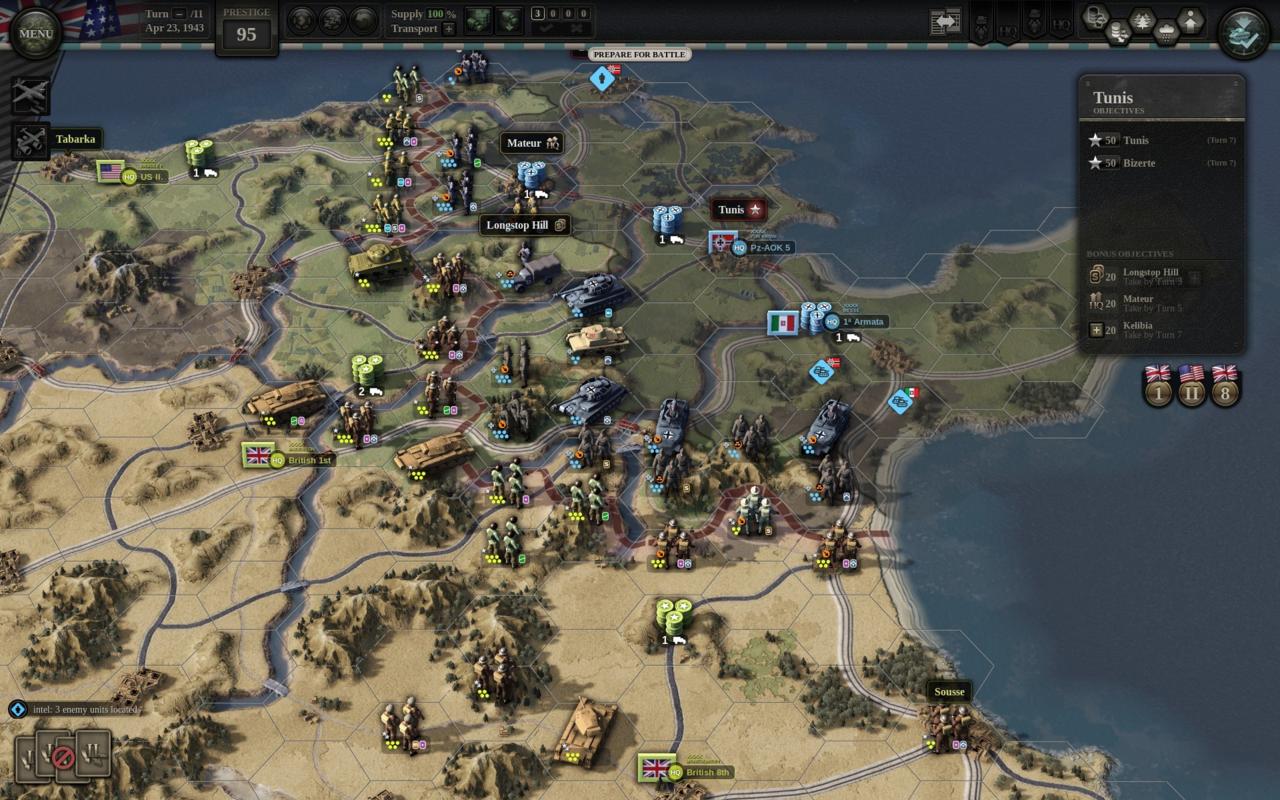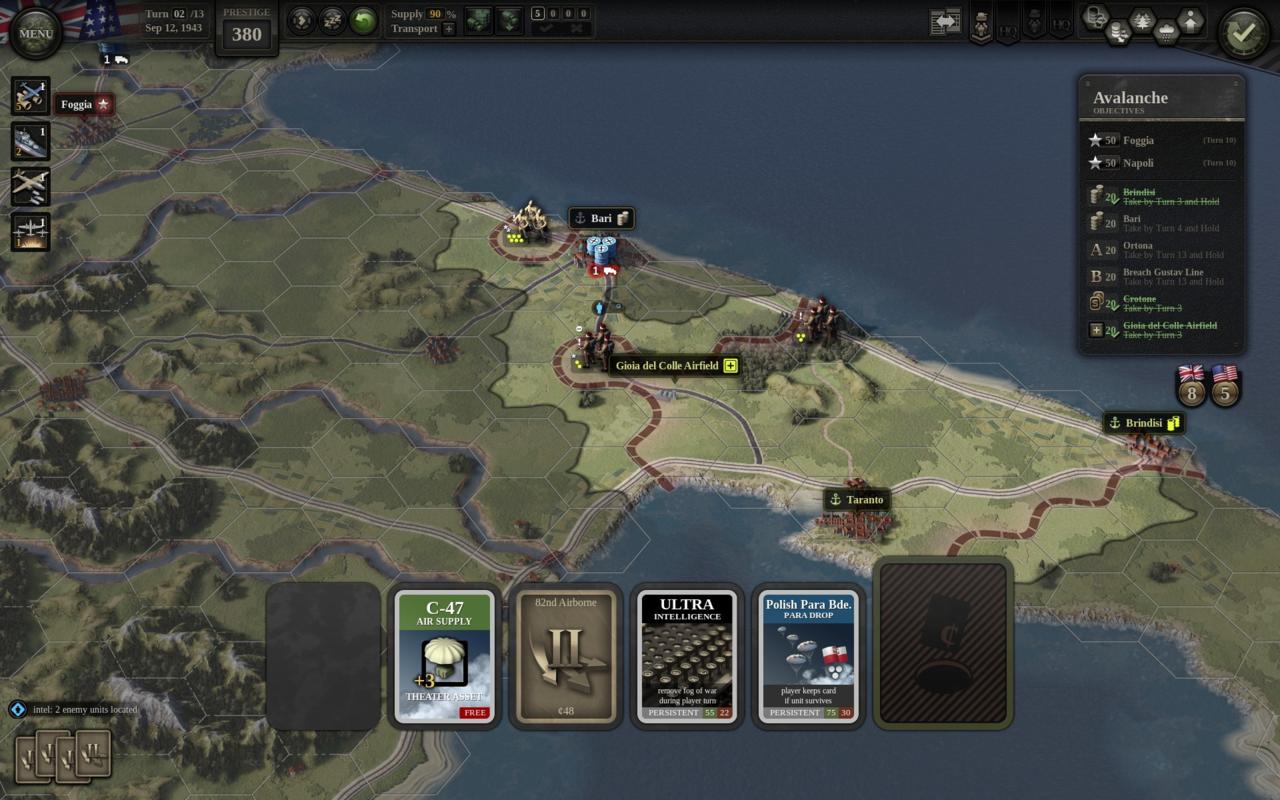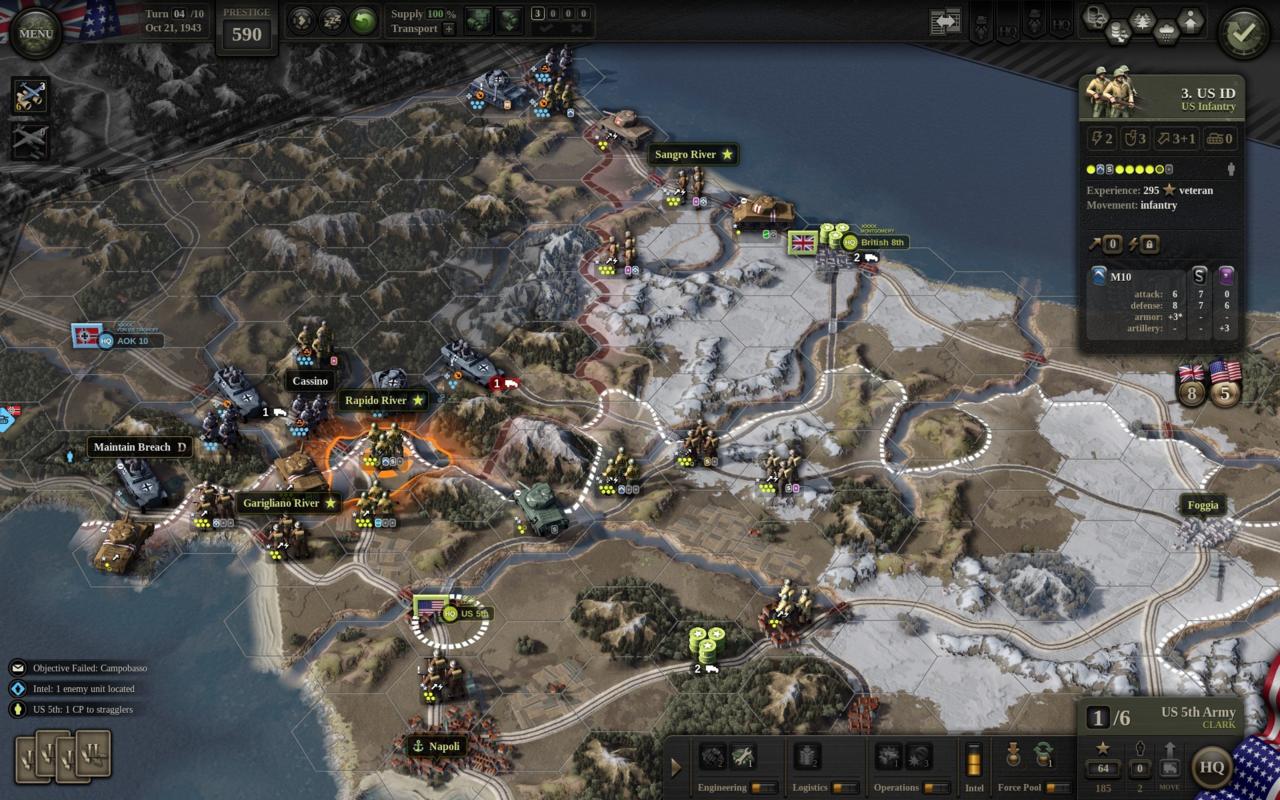At first glance, Unity of Command 2 may look intimidating, the familiarity of the pint-sized tanks and military men that populate its World War II battlefields obscured by an impenetrable fog of unintuitive jargon and confounding icons. But once the confusion clears it reveals a surprisingly straightforward wargame whose keen focus on establishing and severing lines of supply delivers remarkable strategic depth.
This isn't really a strategy game about marching your troops forward to attack the enemy. Unity of Command 2's twist on the genre makes it a game about manoeuvring your units to occupy spaces that maintain clear supply lines to your forces and deny supply to the enemy. In fact, the winning move often involves holding your position. Sometimes you don't even need to engage the enemy at all; you just have to starve them out.

Placing you in charge of the Allied forces in 1943, the campaign opens in North Africa before pushing up through Italy and into the heart of Western Europe. Missions arrive in groups known as conferences, one of the first off-putting terms you'll encounter. At the start of a conference, you can spend prestige points on upgrading your field headquarters, extending their range and efficiency during combat, and on purchasing theatre cards that you can play in battle to grant additional abilities. Beat all the missions in a conference and you unlock the next, along with another chance to upgrade and purchase.
Luck and short-term planning combine here in an interesting way. The cards available to purchase are shuffled randomly, meaning you can't always rely on picking up a favourite and may need to accommodate a curveball or two. And the choices you make are locked in for the duration of the conference, so you've got to manage with what you've got in terms of HQ upgrades and make those cards last over several missions. Knowing you have only three opportunities to use a naval bombardment over the course of a single mission does a lot to focus the mind. Such constraints force you to make bold choices about which targets you absolutely must hit and when precisely is the right time to do so. Get these plays right and you feel like the greatest general the world’s ever seen. Extra cards can be collected during missions as you complete certain objectives, but they arrive more as a relief package--an unexpected boon to your cause rather than a way to undermine the decisions you finalised at the last conference.

At the outset of each mission you're able to survey the map and plan your approach. Usually there are a couple of primary objectives that must be fulfilled to complete the scenario, accompanied by a few secondary objectives that, if achieved, offer a bonus reward or even a slight tactical advantage in the next mission. These objectives are designed in such a way to guide you across the map, and the attentive player will glean useful advantages from them. For example, if the objectives ask you to take a certain town by turn 5 and a second town by turn 8, then it's likely that taking the first town will be beneficial to your efforts to take the second. And if you're tasked with taking and holding a location then doing so will undoubtedly accord an ongoing advantage. Clear, concise objectives provide a structure to each mission that makes it easy to digest what's expected of you, and when you should be aiming to have it accomplished.
Rounding out the preparatory phase, the units at your disposal are pre-assigned as per the scenario, so you're never burdened with choosing whether or not to deploy the US 13th Airborne or the 7th British Armoured Division--they're already there, conveniently positioned on a hex, ready to go. Although units come in only two types--tank and infantry divisions--there's a host of critical attributes that can distinguish one tank division from the next, assuming you can get your head around the collection of arcane icons used to describe them.

Units are composed of "steps," an offputting, unfamiliar term that basically measures the health of the unit. All else being equal, a five-step unit will beat a three-step unit. Yet in these variable battlefields, things are rarely equal. Tiny stars and crosses next to a unit indicate whether it's an elite, veteran or regular unit, but these icons are all-too-easily missed, and even after dozens of hours of play I still found myself occasionally not noticing I was sending a regular infantry to their doom against an elite. Other, multi-coloured symbols represent various specialists serving in the division, but there's no tooltip or in-game explanation as to how a specialist can benefit a unit. I had to rely on an external guide, alt-tabbing out to remind myself that the dark blue icon with the chevron indicated a self-propelled anti-tank specialist while the chevron and dot meant it was a towed anti-tank specialist. There's a lot to remember and keep track of, and unfortunately, the tutorials and in-game tooltips aren't up to the job.
However, once you've taken stock there's the opportunity to make some last-minute adjustments, adding more regular or specialist units to this squad or that, to better suit the strategic gambit you wish to employ. Deploying an engineer specialist to the siege at your primary objective will help whittle away the enemy's fortification bonuses, but maybe you're better off assigning them to the infantry in the east to help ford all those rivers and secure a secondary objective? All these resources are limited, though, and the trade-offs you're forced into always carry weight.
The importance of every decision you make is heightened by the tight turn limit applied to each mission. Of course, you're free to take all the time in the world on each turn. But Unity of Command 2 is a wargame with a fast turnover, and that's precisely what makes it so accessible. Brief skirmishes are the order of the day rather than long, drawn-out stalemates. Often you'll be asked to tick off secondary goals within three or four turns while 10 or 12 turns is a generous amount of time to secure the primary objectives. Experimentation is encouraged by the short time scale. Roll the dice on one strategy, fail quickly, and then before you know it you're back at the battle planning stage, pondering a more effective approach based on the lessons taught by your unsuccessful sortie.

Battles are won through a combination of clear, decisive strikes and a conservative support structure that can swiftly respond to any breach in your line. The way you have to manage logistics through the supply line system turns what could have been a puzzle game about finding the correct solution into a meaty strategy game brimming with flexibility. Victory is all about identifying where you really need to break through the enemy line to secure that vital railroad junction that will cut off supply to every enemy unit in a particular region of the map. Or it's about realising that you can drop those paratroopers behind enemy lines to blow up a bridge that will deny the Germans' ability to keep supplying the frontline. Seeing your plan executed successfully is incredibly satisfying, but at the same time, it's still entertaining to see a plan fall apart as enemy tanks overrun a key chokepoint, suddenly finding yourself scrambling to hold the line and divert supply to your now-stranded troops.
Unity of Command 2 is an overall excellent wargame. The early going can be tough as it takes time to acclimatise to some idiosyncratic terms and learn to interpret the raft of poorly-explained icons. Persistence--not to mention some handy community-written guides--does pay off, though. Stick with it, and you'll be rewarded with one of the finest strategy games in recent times.